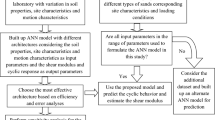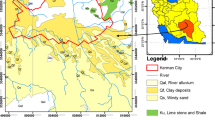Abstract
The quaternary alluvium deposit in the Middle Ganga Plain (MGP) consists of a thick layer of cohesionless soil. The chances of liquefaction at shallow depth in this deposit become high due to the presence of a loose state of the soil. Very few studies can be found in the literature on the large strain cyclic behaviour of soil at MGP. Therefore, this paper has been focused on modelling the cyclic behaviour of saturated cohesionless soil collected from the quaternary alluvium at the MGP. Three different comparatively simple methods using regression, statistical and neural network approaches have been adopted in this study. The feasibility of developed statistical, regression and artificial neural network model for predicting shear modulus and excess pore water pressure has been investigated. The database used for the development of these models comprises a series of 42 cyclic triaxial tests conducted for different site conditions and motion characteristics. It is observed that the neural network method can predict the nonlinear cyclic behaviour more accurately (coefficient of determination is 0.995 and 0.992, respectively, for the prediction equation of shear modulus degradation and EPWP ratio development) compared to other studied methods. Additional cyclic triaxial tests at different displacement amplitude have also been performed for different effective confining stresses. The results from these tests and some other experimental results available in the literature on different sands have been used to validate the proposed models.















Similar content being viewed by others
Availability of data and material
All data, models, or codes that support the findings of this study are available from the corresponding author upon reasonable request.
Code availability
No code was generated or used during the study.
References
Adampira M, Derakhshandi M (2020) Influence of a layered liquefiable soil on seismic site response using physical modelling and numerical simulation. Eng Geol 266:105462
Andrus RD, Piratheepan P, Ellis BS et al (2004) Comparing liquefaction evaluation methods using penetration-VS relationships. Soil Dyn Earthq Eng 24:713–721
Araei AA, Razeghi HR, Tabatabaei SH, Ghalandarzadeh A (2012) Loading frequency effect on stiffness, damping and cyclic strength of modelled rockfill materials. Soil Dyn Earthq Eng 33:1–18
Arulkumaran S, Sukumar S (2015) Regression model to predict subsurface properties. Int J Earth Sci Eng 8:233–239
ASTM D5311–11 (2013) Standard test method for load controlled cyclic triaxial strength of soil
Baziar MH, Ghorbani A (2005) Evaluation of lateral spreading using artificial neural networks. Soil Dyn Earthq Eng 25:1–9
Baziar MH, Jafarian Y (2007) Assessment of liquefaction triggering using strain energy concept and ANN model: capacity energy. Soil Dyn Earthq Eng 27:1056–1072
Blackwell WJ, Chen FW (2009) Neural networks in atmospheric remote sensing. Artech House
Cabalar AF, Cevik A, Guzelbey IH (2010) Constitutive modelling of Leighton Buzzard sands using genetic programming. Neural Comput Appl 19:657–665
Castro G, Poulos SJ (1977) Factors affecting liquefaction and cyclic mobility. J Geotech Geoenvironmental Eng 103:501–516
Chakrabortty P, Roshan AR, Das A (2020) Evaluation of dynamic properties of partially saturated sands using cyclic triaxial tests. Indian Geotech J 50:948–962. https://doi.org/10.1007/s40098-020-00433-3
Chakrabortty P, Popescu R (2015) Response surface model for settlements of a frame structure founded on liquefiable soil. In: 15th Symposium on Earthquake Engineering. pp 372–384
Chakrabortty P, Pandey AD, Mukerjee S, Bhargava A (2004) Liquefaction assessment for microzonation of Kolkata city. In: 13th world conference on earthquake engineering, Vancouver, BC, Canada August. pp 1–6
Chakrabortty P, Das A, Anil (2021) Effect of soil grain size on liquefaction strength of sandy soil. In: Latha Gali M, Raghuveer Rao P (eds) Geohazards. Lecture Notes in Civil Engineering, vol 86. Springer, Singapore., pp 539–554
Chakrabortty P (2008) Seismic liquefaction of heterogeneous soil: mechanism and effects on structural response. Memorial University of Newfoundland
Chattaraj R, Sengupta A (2016) Liquefaction potential and strain dependent dynamic properties of Kasai River sand. Soil Dyn Earthq Eng 90:467–475
Das A, Chakrabortty P (2020) Influence of motion energy and soil characteristics on seismic ground response of layered soil. Int J Civ Eng 18:763–782
Das A, Chakrabortty P, Popescu R (2021) Assessment of lumped particles effect on dynamic behaviour of fine and medium grained sand. Bull Earthq Eng 19:745–766
Das A, Chakrabortty P (2021a) Large strain dynamic characteristics of quaternary alluvium sand with emphasis on empirical pore water pressure generation model. Eur J Environ Civ Eng 1–24
Das A, Chakrabortty P (2021b) Artificial neural network and regression models for prediction of free-field ground vibration parameters induced from vibroflotation. Soil Dyn Earthq Eng 148:106823
Das SK (2013) Artificial neural networks in geotechnical engineering: modelling and application issues. In: Metaheuristics in Water Geotech Transp Eng. pp 231–267
Dave TN, Dasaka SM (2012) Assessment of portable travelling pluviator to prepare reconstituted sand specimens. Geomech Eng 4:79–90
Dief HM, Figueroa JL (2007) Liquefaction assessment by the unit energy concept through centrifuge and torsional shear tests. Can Geotech J 44:1286–1297
Egbe JG, Ewa DE, Ubi SE et al (2017) Application of multilinear regression analysis in modelling of soil properties for geotechnical civil engineering works in Calabar South. Niger J Technol 36:1059–1065
Elham A, Honarjoo N (2013) Comparison of artificial neural network with multiple linear regression in predicting soil pore size distributions. Int J Agric Crop Sci 5:2947
Ellis GW, Yao C, Zhao R, Penumadu D (1995) Stress-strain modelling of sands using artificial neural networks. J Geotech Eng 121:429–435
Eseller-Bayat EE, Yegian MK, Alshawabkeh A, Gokyer S (2013) Liquefaction response of partially saturated sands. II: Empirical model. J Geotech Geoenvironmental Eng 139:872–879
Eseller-Bayat EE, Monkul MM, Akin O, Yenigun S (2018) Evaluation of the effect of relative density on liquefaction assessment of sands with plastic and non-plastic fines. Geotechnical Earthquake Engineering And Soil Dynamics V: Liquefaction Triggering, Consequences. And Mitigation. American Society of Civil Engineers Reston, VA, pp 244–254
Garcıa SR, Romo MP, Figueroa-Nazuno J (2006) Soil dynamic properties determination: a neurofuzzy system approach. Control Intell Syst 34:1–11
Garson DG (1991) Interpreting neural network connection weights. AI Expert 6:46–51
Ghayoomi M, Suprunenko G, Mirshekari M (2017) Cyclic triaxial test to measure strain-dependent shear modulus of unsaturated sand. Int J Geomech 17:4017043
Ghodrati A, Aghaei Araei A (2017) Artificial neural networks for modelling shear modulus and damping behaviour of gravelly materials. Int J Geomech 17:4016060
Ghorbani A, Eslami A (2021) Energy-based model for predicting liquefaction potential of sandy soils using evolutionary polynomial regression method. Comput Geotech 129:103867
Goh ATC (1996) Neural-network modelling of CPT seismic liquefaction data. J Geotech Eng 122:70–73
Green RA, Mitchell JK, Polito CP (2000) An energy-based excess pore pressure generation model for cohesionless soils. In: Proceedings of the John Booker Memorial Symposium, Sidney Australia, AA Balkema Publishers, Rotterdam, Netherlands
Grozic JLH, Robertson PK, Morgenstern NR (2000) Cyclic liquefaction of loose gassy sand. Can Geotech J 37:843–856
Hamzah MO, Golchin B, Jamshidi A, Valentin J (2016) A two level factorial experimental design for evaluation of viscoelastic properties of bitumens containing a surfactant warm additive. In: Proceedings of the E&E Congress 2016 6th Eurasphalt & Eurobitume Congress, Prague, Czech Republic. pp 1–3
Hanumantharao C, Ramana GV (2008) Dynamic soil properties for microzonation of Delhi, India. J Earth Syst Sci 117:719–730
Hardin BO, Black WL (1966) Sand stiffness under various triaxial stresses. J Soil Mech Found Div 92:27–42
Hardin BO, Drnevich VP (1972) Shear modulus and damping in soils: measurement and parameter effects. J Soil Mech Found Div 98:603–624
Hazirbaba K (2005) Pore pressure generation characteristics of sands and silty sands: a strain approach. Doctoral dissertation, The University of Texas at Austin
Hoque MM, Ansary MA, Yasin SJM (2017) Effects of relative density and effective confining pressure on liquefaction resistance of sands. In: the 19th International Conference on Soil Mechanics and Geotechnical Engineering. Seoul, pp 1027–1030
Ishihara K (1996) Soil behaviour in earthquake geotechnics. Oxford University Press, New York
Jafarian Y, Javdanian H (2019) Dynamic properties of calcareous sand from the Persian Gulf in comparison with siliceous sands database. Int J Civ Eng 1–5
Javdanian H (2019) Evaluation of soil liquefaction potential using energy approach: experimental and statistical investigation. Bull Eng Geol Environ 78:1697–1708
Kamatchi P, Rajasankar J, Ramana GV, Nagpal AK (2010) A neural network based methodology to predict site-specific spectral acceleration values. Earthq Eng Eng Vib 9:459–472
Kirar B, Maheshwari BK (2018) Dynamic properties of soils at large strains in Roorkee region using field and laboratory tests. Indian Geotech J 48:125–148. https://doi.org/10.1007/s40098-017-0258-2
Kogut J (2007) Dynamic soil profile determination with the use of a neural network. Comput Assist Mech Eng Sci 14:209–217
Kokusho T (1980) Cyclic triaxial test of dynamic soil properties for wide strain range. Soils Found 20:45–60
Kokusho T (2013) Liquefaction potential evaluations: energy-based method versus stress-based method. Can Geotech J 50:1088–1099
Kramer SL (1996) Geotechnical earthquake engineering. Prentice-Hall international series in civil engineering and engineering mechanics, New Jersey
Kumar SS, Krishna AM, Dey A (2014) Parameters influencing dynamic soil properties: a review treatise. Int J Innov Res Sci Eng Technol an ISO 3:47–60
Kumar SS, Krishna AM, Dey A (2017) Evaluation of dynamic properties of sandy soil at high cyclic strains. Soil Dyn Earthq Eng 99:157–167. https://doi.org/10.1016/j.soildyn.2017.05.016
Liu H, Wang C, Kong G, Bouazza A (2019) Ultimate bearing capacity of energy piles in dry and saturated sand. Acta Geotech 14:869–879
Lo Presti DCF, Berardi R, Pedroni S, Crippa V (1993) A new travelling sand pluviator to reconstitute specimens of well-graded silty sands. Geotech Test J 16:18–26
Luna R, Jadi H (2000) Determination of dynamic soil properties using geophysical methods. In: In 1st International Conference on the Application of Geophysical and NDT Methodologies to Transportation Facilities and Infrastructure, St. Louis, MO. pp 1–15
Lye LM (2003) Some applications of design of experiment methodology in civil engineering. In: Annual Conference of the Candian Society of Civil Engineering. Moncton, Nouveau-Brunswick, Canada
Mital U, Kawamoto R, Andrade JE (2019) Effect of fabric on shear wave velocity in granular soils. Acta Geotech 1–15
Mominul Hoque M (2016) Evaluation of dynamic properties of a sandy soil using cyclic triaxial test. Bangladesh University of Engineering and Technology, Department of Civil Engineering
Mulilis JP, Arulanandan K, Mitchell JK et al (1977) Effects of sample preparation on sand liquefaction. J Geotech Eng Div 103:91–108
Najjar YM, Basheer IA (1996) Utilizing computational neural networks for evaluating the permeability of compacted clay liners. Geotech Geol Eng 14:193–212
Namdarvand F, Jafarnejadi A, Sayyad G (2013) Estimation of soil compression coefficient using artificial neural network and multiple regressions. Int Res J Appl Basic Sci 4:3232–3236
Nemat-Nasser S, Tobita Y (1982) Influence of fabric on liquefaction and densification potential of cohesionless sand. Mech Mater 1:43–62
Nobahar A (2003) Effects of soil spatial variability on soil-structure interaction. Memorial University of Newfoundland, Canada
Olden JD, Joy MK, Death RG (2004) An accurate comparison of methods for quantifying variable importance in artificial neural networks using simulated data. Ecol Modell 178:389–397
Papadimitriou AG, Bouckovalas GD (2002) Plasticity model for sand under small and large cyclic strains: a multiaxial formulation. Soil Dyn Earthq Eng 22:191–204
Pasha SMK, Hazarika H, Yoshimoto N (2020) Estimating dynamic characteristics of gravel-tire chips mixtures using artificial intelligence techniques. J Soc Mater Sci Japan 69:1–8
Penumadu D, Zhao R (1999) Triaxial compression behaviour of sand and gravel using artificial neural networks (ANN). Comput Geotech 24:207–230
Popescu R Prevost JH Deodatis G Chakrabortty P (2006) Dynamics of nonlinear porous media with applications to soil liquefaction. Soil Dyn Earthq Eng 26. https://doi.org/10.1016/j.soildyn.2006.01.015
Prevost JH (1985) A simple plasticity theory for frictional cohesionless soils. Int J Soil Dyn Earthq Eng 4:9–17
Puri N, Jain A, Nikitas G et al (2020) Dynamic soil properties and seismic ground response analysis for North Indian seismic belt subjected to the great Himalayan earthquakes. Nat Hazards 103:447–478
Raghunandan M, Juneja A, Hsiung B (2012) Preparation of reconstituted sand samples in the laboratory. Int J Geotech Eng 6:125–131
Romero S, Pamukcu S (1996) Characterization of granular material by low strain dynamic excitation and ANN. In: Uncertainty in the Geologic Environment: from Theory to Practice. ASCE, pp 1134–1148
Rumelhart DE, Hinton GE, Williams RJ (1985) Learning internal representations by error propagation. California Univ San Diego La Jolla Inst for Cognitive Science
Sadek S, Saleh M (2007) The effect of carbonaceous fines on the cyclic resistance of poorly graded sands. Geotech Geol Eng 25:257–264
Sarmadian F, Mehrjardi RT, Akbarzadeh A (2009) Modelling of some soil properties using artificial neural network and multivariate regression in Gorgan Province, north of Iran. Aust J Basic Appl Sci 3:323–329
Seed RB, Duncan JM (1986) FE analyses: compaction-induced stresses and deformations. J Geotech Eng 112:23–43
Seed HB, Tokimatsu K, Harder LF, Chung R (1984) The influence of SPT procedures on soil liquefaction resistance evaluations. Report No. UCB\EERC-84/15, Earthquake Engineering Research Center, University of California, Berkeley, CA
Sethi IK, Jain AK (2014) Artificial neural networks and statistical pattern recognition: old and new connections. Elsevier
Shafiee A, Ghate R (2008) Shear modulus and damping ratio in aggregate-clay mixtures: an experimental study versus ANNs prediction. J Appl Sci 8:3068–3082
Shahin MA, Maier HR, Jaksa MB (2002) Predicting settlement of shallow foundations using neural networks. J Geotech Geoenvironmental Eng 128:785–793
Shahin MA, Jaksa MB, Maier HR (2009) Recent advances and future challenges for artificial neural systems in geotechnical engineering applications. Adv Artif Neural Syst 2009:
Singh S (1996) Liquefaction characteristics of silts. Geotech Geol Eng 14:1–19
Singh TN, Singh V (2005) An intelligent approach to prediction and control ground vibration in mines. Geotech Geol Eng 23:249–262
Sitharam TG, Ravishankar BV, Patil SM (2012) Liquefaction and pore water pressure generation in sand: cyclic strain controlled triaxial tests. Int J Geotech Earthq Eng 3:57–85
Thevanayagam S (1998) Effect of fines and confining stress on undrained shear strength of silty sands. J Geotech Geoenvironmental Eng 124:479–491
Tizpa P, Chenari RJ, Fard MK, Machado SL (2015) ANN prediction of some geotechnical properties of soil from their index parameters. Arab J Geosci 8:2911–2920
Tsompanakis Y, Lagaros ND, Psarropoulos PN, Georgopoulos EC (2009) Simulating the seismic response of embankments via artificial neural networks. Adv Eng Softw 40:640–651
Tsuchida H (1970) Evaluation of liquefaction potential of sandy deposits and measures against liquefaction induced damage. In: Proceedings of the annual seminar of the Port and Harbour Research Institute. p (3–1)-(3–33)
Uzuoka R, Sento N, Kazama M, Unno T (2005) Landslides during the earthquakes on May 26 and July 26, 2003 in Miyagi, Japan. Soils Found 45:149–163
Vaid YP, Sivathayalan S (2000) Fundamental factors affecting liquefaction susceptibility of sands. Can Geotech J 37:592–606
Vaid YP, Sivathayalan S, Stedman D (1999) Influence of specimen-reconstituting method on the undrained response of sand. Geotech Test J 22:187–195
Varghese R, Amuthan MS, Boominathan A, Banerjee S (2019) Cyclic and postcyclic behaviour of silts and silty sands from the Indo Gangetic Plain. Soil Dyn Earthq Eng 125:105750
Wang G, Xie Y (2014) Modified bounding surface hypoplasticity model for sands under cyclic loading. J Eng Mech 140:91–101
Wijewickreme D, Sanin MV (2006) New sample holder for the preparation of undisturbed fine-grained soil specimens for laboratory element testing. Geotech Test J 29:242–249
Wilson JF, Sáez E (2017) Use of discrete element modelling to study the stress and strain distribution in cyclic torsional shear tests. Acta Geotech 12:511–526. https://doi.org/10.1007/s11440-017-0526-4
Yoshimi Y, Tanaka K, Tokimatsu K (1989) Liquefaction resistance of a partially saturated sand. Soils Found 29:157–162
Zangeneh N, Azizian A, Lye L, Popescu R (2002) Application of response surface methodology in numerical geotechnical analysis. In: Proc. 55th Canadian Society for Geotechnical Conference, Hamilton
Zhang B, Muraleetharan KK, Liu C (2016) Liquefaction of unsaturated sands. Int J Geomech 16:D4015002
Zhang P, Yin Z, Jin Y, Ye G (2020) An AI-based model for describing cyclic characteristics of granular materials. Int J Numer Anal Methods Geomech 44:1315–1335
Zhao T, Yang G, Xi J, et al (2020) Factorial experiment study on the mechanical properties of sandstone–concrete specimens under different freeze-thaw conditions. Front Phys 322
Funding
The first author acknowledges the Department of Higher Education (Government of India) for providing the funding in present research work to carry out the doctoral research study for which no specific grant number is allotted.
Author information
Authors and Affiliations
Contributions
All authors contributed to the study conception and design. Material preparation, data collection and analysis were performed by Dr Angshuman Das and Dr Pradipta Chakrabortty. The first draft of the manuscript was written by Dr Angshuman Das, and all authors commented on previous versions of the manuscript. All authors read and approved the final manuscript.
Corresponding author
Ethics declarations
Conflict of interest
The authors declare no competing interests.
Additional information
Responsible Editor: Zeynal Abiddin Erguler
This paper was selected from the 3rd Conference of the Arabian Journal of Geosciences (CAJG), Tunisia 2020.
Rights and permissions
About this article
Cite this article
Das, A., Chakrabortty, P. Simple models for predicting cyclic behaviour of sand in quaternary alluvium. Arab J Geosci 15, 385 (2022). https://doi.org/10.1007/s12517-022-09639-6
Received:
Accepted:
Published:
DOI: https://doi.org/10.1007/s12517-022-09639-6




